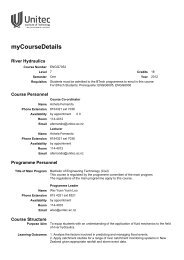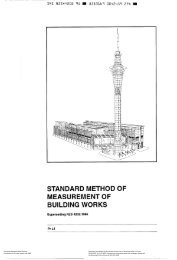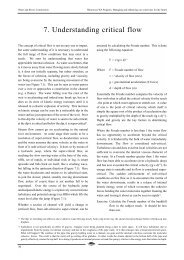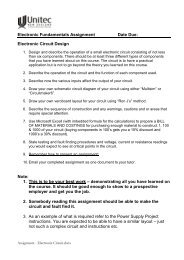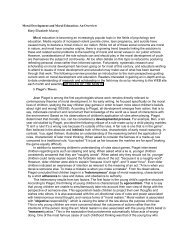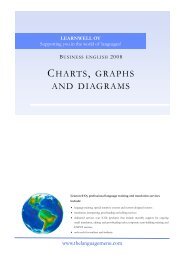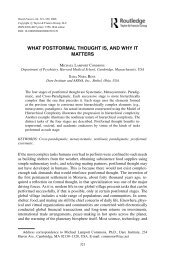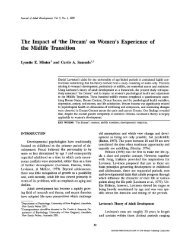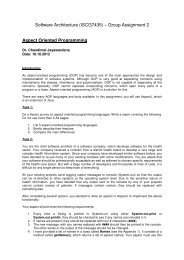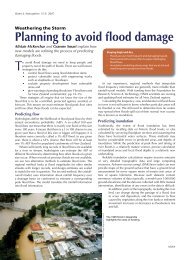Ownership of Land
Ownership of Land
Ownership of Land
Create successful ePaper yourself
Turn your PDF publications into a flip-book with our unique Google optimized e-Paper software.
Unit Standard 23134<br />
Unit Standard 23134<br />
Demonstrate knowledge <strong>of</strong> land ownership, transfer <strong>of</strong> ownership, and<br />
titles<br />
1
Property – Real and Personal<br />
Unit Standard 23134<br />
<strong>Ownership</strong> <strong>of</strong> <strong>Land</strong><br />
Property is everything which can be owned. It includes land and all<br />
objects (tangible property) and rights (intangible property).<br />
Real property, also called realty, is immovable property – i.e., land and<br />
interests in land. This includes the surface <strong>of</strong> the land and most things growing<br />
on it, anything permanently fixed to the land (buildings, swimming pools etc),<br />
some airspace above the land (enough for the owner to be able to use and<br />
enjoy the land but not so much as to impede the flight <strong>of</strong> aircraft above the<br />
land) and anything beneath the surface (except for valuable minerals like<br />
gold and oil which belong to the Crown).<br />
The term “real property” arose in English law after the Norman<br />
conquest (1066) from the kind <strong>of</strong> court action that an individual was<br />
able to take against another who deprived him <strong>of</strong> his land. The owner<br />
<strong>of</strong> the land could bring an action to recover the land, because the<br />
land itself is indestructible and so can be recovered. The owner was<br />
entitled to recover the land, and the action was called a real action.<br />
Personal property is all other property which can be owned. Personal<br />
property can be divided into two main categories:<br />
Choses in possession<br />
Choses in action<br />
The word chose is French for thing, and in law is applied to personal<br />
property.<br />
Choses in possession are tangible items – we <strong>of</strong>ten call them goods or<br />
chattels. They are things that a person can own, touch and move and<br />
include such items as cars, jewellery, furniture and livestock. As the owner,<br />
you have possession <strong>of</strong> these things.<br />
Choses in action are intangible, they do not have a physical presence.<br />
Therefore, as the owner you do not have possession, but the right <strong>of</strong> legal<br />
2
Unit Standard 23134<br />
action. Choses in action are rights, not items, and include company shares,<br />
intellectual property, trademarks, patents, goodwill, debts and cheques.<br />
(Whilst a cheque is a piece <strong>of</strong> paper which has a physical presence the value<br />
<strong>of</strong> the paper itself is negligible, it is merely evidence <strong>of</strong> a right against the<br />
payer.) If you wish to enforce your legal right over this kind <strong>of</strong> property you<br />
must do so by court action - hence the term choses in action.<br />
There is a third category <strong>of</strong> personal property which relates only to<br />
leasehold land: chattels real.<br />
Chattels real means leases in leasehold land. When land is held under a<br />
leasehold title the lease itself is considered personal property (rather than real<br />
property) because there is no ownership in the land itself, there is merely a<br />
right to use the land.<br />
As the term realty refers to real property, so the term personalty refers to<br />
personal property.<br />
<strong>Ownership</strong> and Possession<br />
<strong>Ownership</strong> is a status that confers on a person the greatest range <strong>of</strong> rights<br />
over property.<br />
Property rights may include:<br />
1. The right to control the use <strong>of</strong> the property<br />
2. The right to give possession to another<br />
3. The right to any benefit from the property (such as rent)<br />
4. The right to transfer ownership or sell the property<br />
5. The right to exclude others from the property<br />
In law, having ownership means having title to the property.<br />
<strong>Ownership</strong> can be obtained by purchase, through a gift, by a devise (gift)<br />
in a will, by the establishment <strong>of</strong> a trust or by operation <strong>of</strong> law.<br />
Possession is the right <strong>of</strong> control over a property and usually includes the<br />
right <strong>of</strong> use. If an item is obtained under a hire purchase arrangement<br />
ownership remains with the seller until the item is paid for, while the buyer has<br />
possession.<br />
Possession may be obtained legally or illegally. The law will protect a<br />
person’s rights <strong>of</strong> legal possession. However, possession can be turned over<br />
by someone else’s legal evidence <strong>of</strong> ownership. For instance, if a car is stolen<br />
and then sold to an innocent party, the innocent party (the buyer) has<br />
3
Unit Standard 23134<br />
possession. However, the owner is still the person from whom the car was<br />
stolen. The buyer, as an innocent party, has rights against the person who<br />
sold the car, but no legal rights to the car itself.<br />
In relation to land, ownership means having title to the land and<br />
possession means having the rights to control and use the land.<br />
<strong>Land</strong> <strong>Ownership</strong> in New Zealand<br />
In New Zealand land can legally be owned by anyone, assuming that<br />
person has the legal capacity to do so, and if the purchaser is an overseas<br />
resident that the purchase is not in breach <strong>of</strong> the Overseas Investment Act.<br />
A Certificate <strong>of</strong> Title (C/T) is issued for each parcel <strong>of</strong> land, which gives the<br />
names <strong>of</strong> the owners and is updated every time the land changes hands.<br />
These title documents have been for many years held in the <strong>Land</strong> Titles Office<br />
(LTO) for the district in which the land is situated. The LTO in Auckland is in the<br />
Price Waterhouse Centre in Federal St. However, in recent years the title<br />
information has been computerised, and is now available online. If you apply<br />
for a title search today you will receive a “Computer Register” copy from LINZ<br />
(<strong>Land</strong> Information New Zealand).<br />
The Certificate <strong>of</strong> Title will always show an identifying number (called<br />
“identifier” on the computerised titles) and the legal description <strong>of</strong> the land<br />
(the lot number, and the reference number for the deposited plan (the plan<br />
which was deposited showing the subdivision <strong>of</strong> the land into the relevant<br />
lots). The Certificate <strong>of</strong> Title will also show any other interests registered<br />
against the land, such as mortgages, easements or leases. (These registered<br />
interests were known as “memorials” on the original Certificates <strong>of</strong> Title, but on<br />
the computer versions they are simply called “interests”.)<br />
Most land in New Zealand is owned under a “Freehold” title, which will<br />
show on the title as “an estate in fee simple”. This type <strong>of</strong> ownership is not<br />
limited by time, in other words ownership is “for ever”.<br />
If you own freehold land it is yours to keep, sell or dispose <strong>of</strong> as you wish. If<br />
you die, the land will be passed on to your legal heirs. If however you die<br />
without a will and with no heirs, the land will revert to the Crown.<br />
The Resource Management Act 1991 gives local city or district councils the<br />
right to control what you do with your land, and so before you build on it or<br />
decide to use it as a rubbish dump you will need to obtain their approval. The<br />
Council also has the right to levy charges (rates) against the land.<br />
4
Unit Standard 23134<br />
The Torrens system and Indefeasibility <strong>of</strong> Title<br />
The land registration system in New Zealand is called the Torrens System.<br />
It was first introduced in South Australia in 1858 and was devised by Sir Robert<br />
Torrens, an Irish immigrant to Australia. This system is now used, with some<br />
variations, throughout Australia, New Zealand, the UK and Ireland, much <strong>of</strong><br />
Canada and some States in the USA. The system works on the principle <strong>of</strong> a<br />
registry <strong>of</strong> titles rather than a deeds system. It is based on the principle that<br />
title to a parcel <strong>of</strong> land cannot pass to another person, and no encumbrance<br />
can be enforced, unless it is noted on a land register. Registered title is then<br />
deemed to be absolute and indefeasible, i.e. it is guaranteed, or effectively<br />
insured, by the State.<br />
An indefeasible title is protected from claims by other parties, such<br />
as previous owners. As long as there is no fraud involved the title is<br />
guaranteed and cannot be displaced.<br />
Once you have legal title to a parcel <strong>of</strong> land, that title is indefeasible. S64<br />
<strong>of</strong> the <strong>Land</strong> Transfer Act 1952 is headed “Title Guaranteed to Registered<br />
Proprietor” and states: Subject to the provisions <strong>of</strong> Part 1 <strong>of</strong> the <strong>Land</strong> Transfer<br />
Amendment Act 1963, after land has become subject to this Act, no title<br />
thereto, or to any right, privilege, or easement in, upon, or over the same,<br />
shall be acquired by possession or user adversely to or in derogation <strong>of</strong> the<br />
title <strong>of</strong> the registered proprietor. In other words, once the land is registered as<br />
yours, no-one else can claim it.<br />
The registry <strong>of</strong> titles is maintained by LINZ (<strong>Land</strong> Information New Zealand).<br />
Some titles will include the words limited as to parcels or limited as to title.<br />
If a title is limited as to parcels the boundaries and land area are not<br />
guaranteed because the original survey <strong>of</strong> the land was not completed to<br />
standards that are acceptable today. This limitation may be removed with<br />
an appropriate survey. <strong>Land</strong> that is limited as to title may have other<br />
ownership claims on it, and the title itself is not guaranteed.<br />
When a property sells, the purchaser (usually through their solicitor) will<br />
obtain a guaranteed search <strong>of</strong> the title. This guaranteed search must be<br />
obtained within two weeks before the sale settles and will effectively<br />
guarantee the title for two months after settlement – this means that if a claim<br />
was in the process <strong>of</strong> being lodged on the title at the time <strong>of</strong> settlement, and<br />
it’s existence doesn’t show up until after settlement, the Government will<br />
provide compensation. Terranet describes it as follows:<br />
A Guaranteed Title details all current interests in a property<br />
and any pending transactions at the time that the Title was<br />
5
Unit Standard 23134<br />
extracted. This Title is the main document used in the transfer <strong>of</strong><br />
the ownership <strong>of</strong> property, just prior to the transfer, to ensure<br />
there are no transactions about to be lodged on the Title. The<br />
Guaranteed Title has a key role in terms <strong>of</strong> the Crown's<br />
guarantee <strong>of</strong> title <strong>of</strong> property as set out in section 172A <strong>of</strong> the<br />
<strong>Land</strong> Transfer Act 1952.<br />
After the house sells LINZ changes the details in the registry and<br />
records the new owners names on the title.<br />
The Effect <strong>of</strong> Registration<br />
Prior to settlement, the purchaser has an equitable interest in the land.<br />
After settlement, and registration <strong>of</strong> the purchaser as the new proprietor, the<br />
estate becomes a legal estate. Registration is therefore essential.<br />
In the case <strong>of</strong> competing claims on the same parcel <strong>of</strong> land, it is the<br />
timing <strong>of</strong> registration which determines the legal interest (or lack there<strong>of</strong>) <strong>of</strong><br />
each party.<br />
The effects <strong>of</strong> registering an interest in land:<br />
Transfer <strong>of</strong> Titles<br />
Registration confers an interest in the land<br />
Registration determines the priorities between competing<br />
claims<br />
Registration gives notice to the whole world <strong>of</strong> the interest<br />
Registration without fraud confers an indefeasible title<br />
Titles can be transferred several ways:<br />
By sale<br />
By gift<br />
By will<br />
By transmission/operation <strong>of</strong> law<br />
By trust<br />
Sale is the most common method <strong>of</strong> transfer. The real estate agent<br />
negotiates the terms <strong>of</strong> sale and the transfer documents are drawn up by the<br />
6
Unit Standard 23134<br />
purchaser’s solicitor, and once signed by the purchaser are sent to the<br />
vendor’s solicitor to enable the final signatures.<br />
A gift is the transfer <strong>of</strong> property from one person to another, with no<br />
payment or other consideration taking place in exchange. It is intended that<br />
the donee (the person who receives the gift) will keep the property and not<br />
return it to the donor (the person who gives it).<br />
<strong>Ownership</strong> <strong>of</strong> land can be transferred by will when someone dies, as long<br />
as the will is valid. When a person dies, if that person was the sole owner <strong>of</strong><br />
the land, the land can be passed on to any other person or group <strong>of</strong> people<br />
through a valid will.<br />
Title can be transferred by transmission (operation <strong>of</strong> law) when there is a<br />
joint tenancy (see paragraph on joint tenancy above) and one <strong>of</strong> the joint<br />
tenants dies. If there were two joint tenants (such as a husband and wife),<br />
and one dies, the survivor now becomes the sole owner. Title can also be<br />
transferred by transmission in the case <strong>of</strong> bankruptcy where the Official<br />
Assignee becomes the new owner.<br />
When a property is owned by a trust there will be nominated trustees and<br />
beneficiaries. The trustees hold the property for the benefit <strong>of</strong> the<br />
beneficiaries. Trusts may be created so that the trustees can dispose <strong>of</strong> the<br />
property (to the beneficiaries) during their lifetime, or, more commonly, after<br />
their death.<br />
Information on Title Documents<br />
As well as specifying the identifying number for the certificate <strong>of</strong> title, the<br />
title document will include:<br />
The legal description (Lot and Deposited Plan numbers, and if<br />
applicable, flat and unit numbers and deposited plan numbers for the<br />
flats plan or unit plan)<br />
The size <strong>of</strong> the land (always specifying “more or less”, because the size<br />
is to the closest square metre)<br />
The names <strong>of</strong> the owners (proprietors)<br />
Any easements over the land (such as rights <strong>of</strong> way, rights to drain<br />
water etc)<br />
Any land covenants which have been registered<br />
Fencing covenants, if applicable<br />
Mortgages, if applicable<br />
Caveats, liens etc if applicable<br />
Building line restrictions, if applicable<br />
Other registered interests which affect the property<br />
7
Unit Standard 23134<br />
A mortgage is a registered security – there is a guarantee that the<br />
mortgage will be repaid to the bank. The mortgage is therefore secure. If it<br />
is not repaid in accordance with the terms <strong>of</strong> the mortgage, the bank has the<br />
right to sell the property under a mortgagee sale and recover the debt<br />
owing.<br />
All interests registered on a title are noted on the title. This notation does<br />
not give the full story, it just states that the interests are there. However, each<br />
entry includes a reference number, and full details are available by searching<br />
this reference number.<br />
Easements and Covenants<br />
Many titles show easements or covenants. An easement is a right to cross<br />
someone else’s land for a particular purpose. A common easement is a right<br />
<strong>of</strong> way – this gives another person the right to physically cross your land.<br />
Often a right <strong>of</strong> way is designed to give access to a rear lot and appears as a<br />
driveway. We <strong>of</strong>ten use the term “right <strong>of</strong> way” to mean a driveway which<br />
provides access to a rear lot but in many cases this access is not legally a<br />
right <strong>of</strong> way over someone else’s land, it may be a narrow access strip owned<br />
by the owner <strong>of</strong> the rear lot and it actually forms part <strong>of</strong> the rear lot. You<br />
therefore need to differentiate between the legal meaning <strong>of</strong> “right <strong>of</strong> way”<br />
and the meaning in common use.<br />
A right <strong>of</strong> way could be foot access (a path) or vehicle access (a<br />
driveway).<br />
Other easements may give someone the right to drain water under your<br />
land or to pipe water or gas, or to provide power or telephone services to<br />
their property over or under your land.<br />
Covenants start out as agreements between the person selling the land<br />
and the person buying it that a particular thing will or will not be done. These<br />
covenants are registered on the title and all subsequent owners will also be<br />
bound by them. In a modern subdivision there will <strong>of</strong>ten be covenants<br />
registered on the title. These may stipulate such things as the type and style <strong>of</strong><br />
house that the purchaser is allowed to build or the maximum length that the<br />
purchaser will allow the grass to grow to before the building work starts.<br />
You may see covenants for the following:<br />
Minimum floor size <strong>of</strong> house<br />
Prohibited materials (eg corrugated iron, second hand<br />
materials)<br />
Minimum construction value<br />
Permitted exterior colour schemes<br />
No fencing <strong>of</strong> the front garden, or fencing <strong>of</strong> a particular type<br />
Maximum/minimum number <strong>of</strong> storeys<br />
8
Unit Standard 23134<br />
Cross leased properties <strong>of</strong>ten have “exclusive use” areas (see the heading<br />
below “types <strong>of</strong> ownership”. These exclusive use areas are agreed between<br />
the owners and recorded on the title as covenants.<br />
Fencing covenants are common on titles. They stem from the time when<br />
the lots in the new subdivision were released for sale. When the first lots were<br />
sold, the neighbouring sections were probably still owned by the company<br />
who created the subdivision (the developer). Under the Fencing Act 1978<br />
you have the right to require your neighbour to pay half the cost <strong>of</strong> a<br />
boundary fence, as long as it is an appropriate fence for the purpose (to hold<br />
livestock, or to provide privacy - a farm fence would be different from a<br />
residential fence). In the case <strong>of</strong> a new subdivision the neighbour is the<br />
developer, and a fencing covenant allows the developer to contract out <strong>of</strong><br />
their obligations under the Fencing Act. The person buying the new section<br />
agrees not to exercise their rights under the Fencing Act to require the<br />
developer to pay half the cost <strong>of</strong> the boundary fence. If there were no<br />
fencing covenants the developer would be paying for a lot <strong>of</strong> boundary<br />
fences.<br />
Fencing covenants automatically expire after 12 years.<br />
Caveats and Liens<br />
If a person claims to have a beneficial interest in a parcel <strong>of</strong> land, that<br />
person may lodge a caveat. Once the caveat is on the title it gives notice to<br />
the whole world <strong>of</strong> that interest in the land and it prevents the owner from<br />
selling the land (transferring the title) or allowing any new covenants to be<br />
registered, or granting any new easements over the land.<br />
Liens can no longer be registered against titles, but existing liens may be<br />
enforced. A lien may have been registered where someone has done work<br />
on the land, or supplied materials, and has not been paid by the land owner.<br />
So if a builder built an extension to the house and then was not paid for the<br />
job he may have registered a lien against the title to ensure payment<br />
eventually. If the house sells the lien will have to be removed, and the builder<br />
will allow this to take place once he is paid.<br />
Using Titles when Listing and Selling Real Estate<br />
Every time you list or sell a property it is best to obtain the vendor’s details,<br />
and the property’s legal description, from the Certificate <strong>of</strong> Title. You know<br />
9
Unit Standard 23134<br />
the title has correct information recorded on it, and that your listing contract<br />
and sale and purchase agreement will therefore be correct - and signed by<br />
the right people.<br />
The purchaser’s solicitor will always search the title in order to check that<br />
there are no unexpected covenants or easements on the land or other<br />
claims on the property. If the property is cross-leased or a unit title (see below)<br />
the solicitor will check that the flats plan or unit plan is correct. The solicitor<br />
will use the information you supply on the sale and purchase agreement as a<br />
reference to locate the correct certificate <strong>of</strong> title.<br />
If there are unexpected easements, covenants or other restrictions the<br />
purchaser may not wish to proceed with the purchase and may be entitled<br />
to object to the title.<br />
If there are any caveats liens or claims on the property the purchaser will<br />
probably require the vendor to have them removed. If the vendor will not, or<br />
cannot, have these removed the purchaser may cancel the contract.<br />
In the case <strong>of</strong> cross leased properties, or properties held under a unit title,<br />
the relevant plan <strong>of</strong> the dwellings (flats plan or unit plan) must also be<br />
accurate. When the solicitor searches the title the flats plan/unit plan will<br />
also be searched, and if not accurate, may also give grounds to the<br />
purchaser to object to the title.<br />
Types <strong>of</strong> <strong>Ownership</strong><br />
As already discussed, most land in New Zealand is owned under a<br />
Freehold title. There are however several ways <strong>of</strong> owning land.<br />
The two main types <strong>of</strong> ownership are freehold (fee simple) and leasehold.<br />
Freehold/Fee Simple<br />
This is nearly absolute ownership <strong>of</strong> the land. The owner may keep the<br />
land, sell it, gift it or dispose <strong>of</strong> it by will. Assuming council by-laws permit it,<br />
the land may be subdivided into smaller lots, or if the owner owns an<br />
adjoining lot the land may be amalgamated into a larger lot. However, if<br />
the owner dies without a will and without heirs the land will revert to the<br />
Crown.<br />
10
Unit Standard 23134<br />
The legal description <strong>of</strong> freehold land will give a Lot number and a<br />
Deposited Plan (DP) number, e.g. Lot 6 DP 103291.<br />
Leasehold<br />
There is not a lot <strong>of</strong> leasehold land in New Zealand. With a leasehold title<br />
the owner <strong>of</strong> the land leases it to the person whose house is on the land. The<br />
house and land therefore have different owners. The owner <strong>of</strong> the house will<br />
pay “ground rent” to the land owner for the use <strong>of</strong> the land. Leases are <strong>of</strong>ten<br />
for 21 years but on their expiry are usually renewable. The type <strong>of</strong> lease which<br />
is perpetually renewable is called a Glasgow Lease, and upon renewal the<br />
rent will be reviewed. After 21 years, you can imagine that there will be a<br />
very large rent increase! For this reason, many newer Glasgow leases provide<br />
for more frequent rent reviews (perhaps every five or seven years).<br />
At the end <strong>of</strong> the lease term the owner <strong>of</strong> the house may choose to<br />
remove and relocate the house and not renew the lease.<br />
You will notice that when leasehold property is for sale it is usually cheaper<br />
than comparable freehold property, and for this reason real estate agents<br />
<strong>of</strong>ten charge a higher commission.<br />
Most <strong>of</strong> the leasehold land in Auckland is in the St Johns area, owned by<br />
the St Johns Trust and St Johns Church.<br />
Co-ownership <strong>of</strong> land<br />
The words “tenant” and “tenancy” are <strong>of</strong>ten used in connection with<br />
land. In every-day language we use these terms to refer to rented or leased<br />
accommodation, but these words, along with tenacious and tenure, come<br />
from the Latin tenere which means “to hold”. Therefore the terms tenancy<br />
and tenants when used below simply mean holding and have nothing to do<br />
with renting or leasing.<br />
When land is co-owned, all the owners have the right to use and enjoy the<br />
land. The most common methods <strong>of</strong> co-ownership are joint tenancy and<br />
tenancy in common.<br />
Joint tenancy<br />
11
Unit Standard 23134<br />
Two or more people own the land jointly. Every one <strong>of</strong> the joint tenants<br />
has the right to possess the whole <strong>of</strong> the land and if one dies his or her<br />
interest automatically passes to the other(s). All joint tenants have an<br />
equal right to possession <strong>of</strong> the land and share equally their interest in the<br />
land. No-one can sell or dispose <strong>of</strong> their interest independently <strong>of</strong> the<br />
others nor can they will it to any person upon their death – the main<br />
characteristic <strong>of</strong> a joint tenancy is the right <strong>of</strong> survivorship. If the land has<br />
two joint tenants, and one dies, the survivor is entitled to be registered as<br />
sole proprietor <strong>of</strong> the land.<br />
Joint tenancy by spouses – the Joint Family Homes Act 1964 provides<br />
for spouses to own the family home jointly as joint tenants. However,<br />
more recent legislation (Property Relationships Act 1976, which has<br />
updated the Matrimonial Property Act 1976) and the growing trend<br />
towards family trusts has superseded most <strong>of</strong> the benefits <strong>of</strong> this Act.<br />
Some people still own their family homes this way and will wish to settle<br />
any new purchase under this Act, but is now infrequently used.<br />
Tenancy in common<br />
Again, two or more people own the land between them, but with a<br />
tenancy in common they own defined, but undivided, shares. Shares do<br />
not have to be equal, although <strong>of</strong>ten they are: two tenants in common<br />
might each have an undivided one half share, or, if shares are not equal,<br />
one might own, say, an undivided one third share whilst the other holds a<br />
two thirds share.<br />
A cross lease is an example <strong>of</strong> ownership by tenants in common.<br />
Under the <strong>Land</strong> Transfer Act 1952, tenants in common can hold<br />
separate title to their interest in the land, and can sell this interest, or, if<br />
they die, will it to any other person. The legal interests <strong>of</strong> the other owners<br />
are not affected. There is no right <strong>of</strong> survivorship.<br />
When business partners buy land as an investment they may choose to<br />
buy it as tenants in common because this will allow them to dispose <strong>of</strong><br />
their shares as and when they choose.<br />
Maori ownership<br />
Maori land ownership is complex. It stems from traditional use <strong>of</strong> Maori<br />
land where ownership was tribal and decisions were made collectively.<br />
Today Maori land ownership is governed by Te Turi Whenua Maori Act<br />
1993 (Maori <strong>Land</strong> Act 1993) and provides for the Maori <strong>Land</strong> Court to<br />
maintain records <strong>of</strong> ownership.<br />
12
Unit Standard 23134<br />
If you are searching a title to Maori freehold land you should check<br />
records both through LINZ and through the Maori <strong>Land</strong> Court. The court<br />
holds all title records for all Maori freehold land.<br />
Most Maori land is registered with two or more proprietors as tenants in<br />
common. An owner <strong>of</strong> an undivided interest in Maori freehold land can<br />
separately alienate that interest – but only to a certain class <strong>of</strong> alienee,<br />
usually a blood relative.<br />
The Property Relationships Act 1976 does not apply to Maori <strong>Land</strong>.<br />
Cross Lease, Unit Title and Company Title<br />
Two <strong>of</strong> the most common types <strong>of</strong> title which allow co-ownership <strong>of</strong> land<br />
are cross leases and unit titles. We will look at these, and company titles,<br />
below.<br />
Cross Lease<br />
This is confusing to a lot <strong>of</strong> people. The underlying title is nearly always<br />
freehold so if you buy a cross leased property you are usually buying freehold<br />
land – it’s just that you won’t be the only owner <strong>of</strong> that land. The buildings on<br />
the land are leased. But they are leased from the owners <strong>of</strong> the land – and<br />
you are one <strong>of</strong> them. It is a way <strong>of</strong> allowing several owners to own one piece<br />
<strong>of</strong> land between them whilst giving each one <strong>of</strong> them the rights to use <strong>of</strong> one<br />
<strong>of</strong> the homes on that land.<br />
If you buy a home unit in a block <strong>of</strong> three with a cross lease title you will be<br />
buying a “one third” share in the land, and you will also obtain a lease for 999<br />
years (or if the lease was registered five years ago, the balance - 994 years) in<br />
that home home unit. You therefore have a “composite” title – you have a<br />
share in the freehold and a 999 year lease. The one third share in the land will<br />
be described as “an undivided one third share” because there are three<br />
owners who own the land jointly. (The land is not divided up into thirds, with<br />
any one owner being able to identify their third, it just has three owners with<br />
equal shares.)<br />
A cross lease title will always include the words “Composite Computer<br />
Register” and describe both types <strong>of</strong> estate from which the title is composed<br />
– if the title is for a cross lease on freehold land the title document will show<br />
the estate in fee simple and the estate in leasehold.<br />
However, to make more sense <strong>of</strong> peoples’ rights to use the section,<br />
outdoor living and gardens when there are two or more owners <strong>of</strong> the land,<br />
there are <strong>of</strong>ten exclusive use areas associated with each <strong>of</strong> the dwellings.<br />
This prevents the other owners from using the portion <strong>of</strong> land which has been<br />
13
Unit Standard 23134<br />
allocated to your unit, hence the term “exclusive” – the other owners are<br />
excluded from it. Exclusive use areas show as covenants on the title.<br />
To show which owner has the rights to which home unit, in a cross lease<br />
situation there must always be a flats plan. The flats plan shows the outline <strong>of</strong><br />
the buildings and the exclusive use areas, and it will also show any common<br />
area (<strong>of</strong>ten the driveway) which is able to be used by all owners.<br />
Because the title is composite the legal description for the property will<br />
show both types <strong>of</strong> ownership: firstly the freehold ownership showing the lot<br />
number and DP number, and indicating the share in the land (for instance,<br />
one third), and secondly it will refer to the estate in leasehold showing the<br />
tenure <strong>of</strong> the buildings. A cross lease title may provide the owner with, say,<br />
an undivided one third share in Lot 8 DP 99673, together with an estate in<br />
leasehold created by Lease L.215498.3 in Flat2 DP 104559.<br />
Cross leases may also be registered on leasehold land although these are<br />
quite rare. The length <strong>of</strong> the term <strong>of</strong> the cross lease will be limited by the<br />
length <strong>of</strong> the underlying lease on the leasehold land.<br />
Unit Title<br />
Again, the underlying title is (usually) freehold and this is another method to<br />
allow the land to have multiple owners. It is used most <strong>of</strong>ten for apartments.<br />
A unit title is a title to a defined space (the apartment) and <strong>of</strong>ten includes title<br />
to additional spaces (car park, storage cupboard etc). The apartment<br />
owners own the land between them with their shares in the land being<br />
determined by the size <strong>of</strong> their apartment, i.e. the largest apartment will have<br />
the largest share in the land. There is a body corporate (i.e., all the owners)<br />
which pays for the upkeep <strong>of</strong> the common area and is usually administered<br />
by a body corporate manager (or secretary) and all <strong>of</strong> the owners pay their<br />
appropriate share <strong>of</strong> these costs.<br />
The body corporate knows that one day the building will need major<br />
repairs or renovations, for example the ro<strong>of</strong> may need to be replaced, and<br />
this will be an expensive exercise. So these expenses are planned for in<br />
advance and a fund is put aside to cover them. This fund is called the sinking<br />
fund. Every year all the owners (members <strong>of</strong> the body corporate) contribute<br />
a small amount into the sinking fund and the fund continues to grow.<br />
Eventually, when the major repairs are needed there should be enough<br />
money in the sinking fund to cover the costs.<br />
All money which is contributed into the fund by owners will remain in the<br />
fund until it is needed. If you live in an apartment block for ten years, and<br />
contribute to the fund every year but the fund does not need to be used<br />
during that time, you will not obtain a refund <strong>of</strong> your money when you sell<br />
your apartment. You have enjoyed the use <strong>of</strong> the building during that period<br />
<strong>of</strong> time, and your successor in title must also enjoy the use <strong>of</strong> the building,<br />
even if it requires major repairs.<br />
14
Unit Standard 23134<br />
On the title document the words Unit Title Register appear, and the estate<br />
is described as a Stratum estate. Stratum in Freehold means that the<br />
underlying title to the land is freehold. If the title stated that the estate was<br />
Stratum in Leasehold the underlying title would obviously be a leasehold title.<br />
The legal description for a property held under a Unit title will refer to the<br />
dwelling as the Principal Unit and will identify it with a letter – e.g., Principal<br />
Unit H. There may also be accessory units (the car park space, assigned<br />
garden areas, etc) and these may be described by letters or numbers. A<br />
typical legal description for a unit owned under Unit title could read: Principal<br />
Unit G and Accessory Unit 7 on Unit Plan 234981. There will also be a lot<br />
number, and number for the deposited plan on which the subdivision <strong>of</strong> lots<br />
was lodged at the <strong>Land</strong> Titles Office, but with some unit titles this information is<br />
not easy to find. (The letters PU, if you see them, stand for Principal Unit and<br />
AU for Accessory Unit, and UP stands for Unit Plan.)<br />
An apartment block, along with many types <strong>of</strong> commercial building,<br />
requires a warrant <strong>of</strong> fitness. This must be renewed annually. The warrant <strong>of</strong><br />
fitness is issued once it is proven that the fire alarms, sprinklers and fire escapes<br />
are all functioning correctly, and that such things as lifts are safe and working<br />
as they should. The emergency lighting will also be checked to ensure that it<br />
works. If any <strong>of</strong> these items failed the building will not be safe to live or work<br />
in, so the warrant <strong>of</strong> fitness proves that the building is safe.<br />
Company title<br />
In this case the land is owned by a company, which is set up specifically<br />
for the purpose <strong>of</strong> owning the land. This type <strong>of</strong> ownership was created for<br />
blocks <strong>of</strong> flats, or units, and the “owners” gain the rights to their respective<br />
flats or units by buying shares in the company.<br />
If you sell an apartment or home unit which has a company title, you are<br />
actually selling shares, not land. Therefore, the standard Sale and Purchase<br />
Agreement form does not apply, because this form is used only for land, not<br />
for shares.<br />
Whichever kind <strong>of</strong> title is involved, Clause 5 in the Sale and Purchase<br />
Agreement gives the purchaser the right to search the title to check that<br />
everything is in order. If there are any problems – including problems with<br />
incorrect Flats Plans – the purchaser has 10 working days to object to the title.<br />
Remember, even an unconditional agreement can be voided if the<br />
purchaser discovers a problem or fault with the title.<br />
15
Leases and Licences to Occupy<br />
Unit Standard 23134<br />
Commercial and industrial buildings are usually held under a lease. The<br />
tenant leases the shop, <strong>of</strong>fice, factory or warehouse from the landlord (the<br />
owner <strong>of</strong> the building). Commercial leases are usually for a number <strong>of</strong> years<br />
and <strong>of</strong>ten contain provisions for the lease to be renewed once or twice. For<br />
instance, you may enter into a lease for three years with a right <strong>of</strong> renewal for<br />
a further three years. After the first three years, the tenant has the right to<br />
renew the lease or walk away from it. The landlord however cannot walk<br />
away but must renew the lease if the tenant wishes.<br />
If a tenant wants to (1) sell his or her business to another person, or (2)<br />
vacate the premises and allow another person to take over the lease, the<br />
lease will have to be assigned to the new tenant. Assigning the lease will<br />
require the landlord’s approval. The Property Law Act 2007 states that a<br />
landlord cannot unreasonably withhold consent or delay this consent.<br />
Another form <strong>of</strong> tenure is a licence to occupy. This is the usual<br />
arrangement in a retirement village. In exchange for a fee, and subject to<br />
the terms and conditions set out in the licence, the elderly person has the<br />
right to occupy one <strong>of</strong> the units in the village.<br />
Cross Leases and Problems with Flats Plans<br />
Because <strong>of</strong> the large number <strong>of</strong> properties which are held under a cross<br />
lease title, and because each cross leased property must have a flats plan,<br />
there are a growing number <strong>of</strong> problems associated with flats plans.<br />
When the flats plan is first deposited the details are likely to be correct.<br />
Problems arise however because people who own cross leased properties do<br />
not realise that they must amend the flats plan if they alter the shape <strong>of</strong> their<br />
dwelling after the plan has been lodged.<br />
You will be bound to come across people who add a small conservatory<br />
on to a two bedroom unit – it adds useful, light and airy space and makes the<br />
property much more liveable. Unfortunately, many <strong>of</strong> these people do not<br />
realise that in doing this they have changed the shape <strong>of</strong> the “footprint” <strong>of</strong><br />
the building, and the flats plan is now wrong. Typically, they will have<br />
applied for a permit or consent to build the conservatory. Because they have<br />
obtained the consent from the council, and to do this a plan was submitted,<br />
they think that all legal matters have been completed. The council are not<br />
concerned about flats plans – they just want to make sure that the building<br />
complies with the by-laws and is safe and sanitary. No-one at the council will<br />
tell the home owner that as well as getting a permit they must also amend<br />
the flats plan on their title. Unless the home owner happens to mention the<br />
16
Unit Standard 23134<br />
new conservatory to their solicitor (which is not very likely), it is probable that<br />
they will not discover the shortfall in the flats plan until they come to sell the<br />
property.<br />
If they sell the property without attending to the flats plan the prospective<br />
purchaser will search the title and find that the title has a fault – the flats plan<br />
does not match what is being sold. Even an unconditional sale could fall<br />
over because <strong>of</strong> this.<br />
In order to correct the flats plan, the home owner will need to obtain the<br />
legal consent <strong>of</strong> all the other owners <strong>of</strong> the land (i.e., the owners <strong>of</strong> all the<br />
other flats in the block), and employ a surveyor to draw an accurate outline<br />
<strong>of</strong> the flat, showing the conservatory. The resulting legal fees and surveyors<br />
charges may push the cost <strong>of</strong> correcting the title documents to around<br />
$3,000 – a cost which the home owner will not be expecting.<br />
The Overseas Investment Act<br />
The Overseas Investment Act prevents non-residents from purchasing<br />
certain categories <strong>of</strong> land without first gaining government approval.<br />
Ordinary suburban property is not likely to be affected by the OIA; the<br />
purpose <strong>of</strong> the Act is to ensure that the best parts <strong>of</strong> New Zealand’s<br />
countryside is not owned <strong>of</strong>f-shore.<br />
The Act applies to:<br />
<strong>Land</strong> in excess <strong>of</strong> 5 hectares (approx 12½ acres)<br />
<strong>Land</strong>/property <strong>of</strong> more than $10,000,000<br />
Waterfront land <strong>of</strong> more than 2,000m² (approx ½ acre)<br />
<strong>Land</strong> on certain <strong>of</strong>f-shore islands<br />
<strong>Land</strong> adjacent to certain reserves <strong>of</strong> high ecological or cultural sensitivity<br />
If you are selling property to an overseas investor and it falls into one <strong>of</strong><br />
these categories it would pay to contact the purchaser’s solicitor and seek his<br />
advice before drawing up the agreement.<br />
Signatories to Real Estate Contracts<br />
17
Unit Standard 23134<br />
If land is to be sold, all the owners whose names appear on the title must<br />
sign the contract. If one person tells you “I can sign for everyone” you will<br />
need to see a properly executed power <strong>of</strong> attorney as pro<strong>of</strong> <strong>of</strong> this claim.<br />
In some cases the person signing the contract may not be the person<br />
whose name appears on the contract as vendor, but may instead be<br />
someone who holds a power <strong>of</strong> attorney for the real owner. If the owner is<br />
overseas, he or she may have appointed someone as their attorney and this<br />
person will sign on their behalf. Again, you should sight the power <strong>of</strong> attorney.<br />
When a property is owned by a family trust there will usually be three or<br />
more owners whose names appear on the title – <strong>of</strong>ten a husband and wife<br />
and a third trustee, perhaps their solicitor. All these people must sign the Sale<br />
and Purchase Agreement, and until all have signed there is no legally binding<br />
contract in place.<br />
Where companies own properties you will need to establish the names <strong>of</strong><br />
the directors <strong>of</strong> the company, and you will also need to know if any one<br />
director has sole signing rights, or, if none have sole signing rights, how many<br />
directors are required to sign the contract. If a company has two directors,<br />
and both have to sign, a listing granted by one <strong>of</strong> them may not be valid if<br />
the other contests it.<br />
Sometimes an additional person will demand to have the right to sign a<br />
contract. A de-facto partner may genuinely believe that he or she has the<br />
right to sign a contract to sell the property, however, if that person’s name<br />
does not appear on the title they have no signing rights. If a partner, or ex<br />
partner, believes that they have a right to a share in the proceedings from<br />
the sale <strong>of</strong> the house they will have to make a claim under the Civil Union Act<br />
2004 but they will not have any right to sign the contract itself.<br />
LIM Reports, Consents and Council Records<br />
Many people confuse the roles <strong>of</strong> the various government bodies when it<br />
comes to details about land. LINZ holds the titles, which deal with ownership.<br />
The local council holds records about the use <strong>of</strong> the land, and issues permits<br />
or consents for work to be carried out on the land. They gain this right<br />
through the Resource Management Act 1991.<br />
Title documents do not show what is built on the land – except in the case<br />
<strong>of</strong> cross leases or unit titles, where the outline <strong>of</strong> the building (or space to<br />
which there is title) is necessary to help define ownership.<br />
18
Sale <strong>of</strong> Goods Act 1908<br />
Unit Standard 23134<br />
As you know, there is a difference between real property and personal<br />
property. <strong>Land</strong> is real property. Chattels are personal property. The contract<br />
for the sale <strong>of</strong> the land is covered by the Sale and Purchase Agreement and<br />
this contract also covers the sale <strong>of</strong> the included chattels. If the house burns<br />
down and the fire destroys the chattels, the contract provides the remedies<br />
for both parties. Clause 4 “Risk and Insurance” in the Sale and Purchase<br />
Agreement explains that the property and chattels shall remain at the risk <strong>of</strong><br />
the vendor until possession is given and taken.<br />
In some cases, after the sale <strong>of</strong> the property has been negotiated, the<br />
vendors will enter into a private agreement with the purchasers to sell them<br />
some additional chattels – perhaps the purchasers are impressed by the<br />
vendors’ lounge suite and would like to buy it. These additional chattels are<br />
not covered by the Sale and Purchase Agreement because they are not<br />
included in that contract. They are covered by a new unrelated contract<br />
(which may not even be signed) and the Sale <strong>of</strong> Goods Act 1908 now<br />
applies. The question now is, when do these additional chattels become the<br />
property <strong>of</strong> the purchaser – and who should have them insured?<br />
S19 <strong>of</strong> the Sale <strong>of</strong> Goods Act says that ownership is transferred at the time<br />
the parties intend it to be transferred:<br />
Property passes when intended to pass<br />
(1) Where there is a contract for the sale <strong>of</strong> specific or ascertained<br />
goods, the property in them is transferred to the buyer at such time as<br />
the parties to the contract intend it to be transferred<br />
Intention may be difficult to ascertain, so s20 <strong>of</strong> the Sale <strong>of</strong> Goods Act<br />
provides the rules for ascertaining intention.<br />
Rules for ascertaining intention<br />
Unless a different intention appears, the following are rules for<br />
ascertaining the intention <strong>of</strong> the parties as to the time at which the<br />
property in the goods is to pass to the buyer:<br />
o Rule 1. Where there is an unconditional contract for the sale <strong>of</strong><br />
specific goods, in a deliverable state, the property in the goods<br />
passes to the buyer when the contract is made, and it is<br />
immaterial whether the time <strong>of</strong> payment or the time <strong>of</strong> delivery,<br />
or both, is postponed.<br />
o Rule 2. Where there is a contract for the sale <strong>of</strong> specific goods,<br />
and the seller is bound to do something to the goods for the<br />
purpose <strong>of</strong> putting them into a deliverable state, the property<br />
does not pass until such thing is done, and the buyer has notice<br />
there<strong>of</strong>.<br />
19
Unit Standard 23134<br />
o Rule 3. Where there is a contract for the sale <strong>of</strong> specific goods in<br />
a deliverable state, but the seller is bound to weigh, measure,<br />
test, or do some other act or thing with reference to the goods<br />
for the purpose <strong>of</strong> ascertaining the price, the property does not<br />
pass until such act or thing is done, and the buyer has notice<br />
there<strong>of</strong>.<br />
o Rule 4. Where goods are delivered to the buyer on approval, or<br />
on sale or return or other similar terms, the property therein<br />
passes to the buyer—<br />
(a) When he signifies his approval or acceptance to the<br />
seller, or does any other act adopting the transaction:<br />
(b) If he does not signify his approval or acceptance to<br />
the seller, but retains the goods without giving notice <strong>of</strong><br />
rejection then, if a time has been fixed for the return <strong>of</strong><br />
the goods, on the expiration <strong>of</strong> such time, and if no time<br />
has been fixed, on the expiration <strong>of</strong> a reasonable time.<br />
What is a reasonable time is a question <strong>of</strong> fact.<br />
o Rule 5.<br />
(1) Where there is a contract for the sale <strong>of</strong><br />
unascertained or future goods by description, and goods<br />
<strong>of</strong> that description and in a deliverable state are<br />
unconditionally appropriated to the contract, either by<br />
the seller with the assent <strong>of</strong> the buyer or by the buyer with<br />
the assent <strong>of</strong> the seller, the property in the goods<br />
thereupon passes to the buyer. Such assent may be<br />
expressed or implied, and may be given either before or<br />
after the appropriation is made.<br />
(2) Where, in pursuance <strong>of</strong> the contract, the seller delivers<br />
the goods to the buyer, or to a carrier or other bailee<br />
(whether named by the buyer or not) for the purpose <strong>of</strong><br />
transmission to the buyer, and does not reserve the right<br />
<strong>of</strong> disposal, he is deemed to have unconditionally<br />
appropriated the goods to the contract.<br />
In most cases where a seller and buyer negotiate the sale <strong>of</strong> additional<br />
chattels after the Sale and Purchase Agreement is signed, Rule 1 above will<br />
apply because it is unlikely that the parties will have made any formal<br />
arrangement regarding the transfer <strong>of</strong> ownership. These chattels are<br />
therefore at the risk <strong>of</strong> the purchaser from the time they enter into the<br />
contract with the vendor, even though they may not yet have paid for them<br />
or have the use <strong>of</strong> them.<br />
Unless the parties formally state a date on which ownership <strong>of</strong> the chattels<br />
is to be transferred it is deemed that ownership transfers at the time the<br />
contract is made.<br />
20



